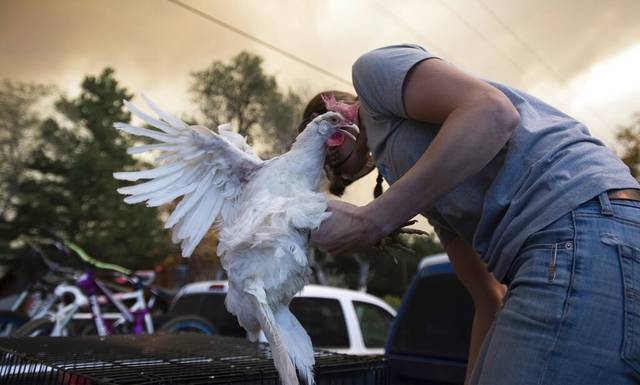https://triblive.com/news/world/fierce-wind-fans-rockies-wildfires-new-evacuations-ordered/
Fierce wind fans Rockies wildfires, new evacuations ordered

CHEYENNE, Wyo. — Strong wind fanned two Rocky Mountain wildfires Wednesday, prompting new evacuation orders as one of them spread toward communities that lie outside Rocky Mountain National Park.
Cool autumn weather had been helping firefighters in their efforts to quell the Mullen Fire in southeastern Wyoming and northern Colorado and the Cameron Peak Fire in northern Colorado, but gusts of 70 mph complicated their overnight efforts.
Forecasters expected dry air and strong wind to pose a challenge for firefighters into the weekend.
[2:30 PM] The #CameronPeakFire continues to produce an extensive smoke plume downstream. Shortwave IR shows that the fire continues to burn very hot this afternoon. #COwx pic.twitter.com/jnccaGzy7L— NWS Boulder (@NWSBoulder) October 14, 2020
The fierce burning was much later in the year than usual. Mountain snows usually are significant enough to end fire season well before mid-October.
The latest evacuations in the path of the Cameron Peak Fire affected mainly recreational properties — including hundreds of mountain cabins — in and around the unincorporated communities of Glen Haven and Drake east of Rocky Mountain National Park.
The fire continued spreading into remote northern Rocky Mountain National Park and was bearing down on the Colorado State University Mountain Campus, a university retreat a few miles north of the park.
“We’re preparing to do whatever is necessary in those areas,” fire operations trainee Tim Daly said in a briefing about the efforts to protect the campus and communities.
The main route to the park from the east, U.S. Highway 34, remained open but evacuation zones for the first time extended into foothills less than 10 miles west of Fort Collins, Colo. The city of 168,000 on the edge of the plains wasn’t at risk but residents awoke Wednesday to thick smoke and poor air quality alerts.
At more than 210 square miles, the Cameron Peak Fire was less than 10 square miles from becoming the biggest in Colorado history. Firefighters fully contained the state’s biggest in history, the Pine Gulch Fire north of Grand Junction, on Sept. 15.
Northern Colorado's been smoked out by wildfires for about two months now, but today's hellview is something else pic.twitter.com/Y0vTBtDpoA— Colby (@colbywg) October 14, 2020
The Cameron Peak Fire has damaged or destroyed 95 buildings, including 33 homes, while the Mullen Fire 25 miles to the north in Medicine Bow National Forest has destroyed or damaged 65 structures. Both fires affected primarily recreational subdivisions and isolated cabins, not cities or towns.
Firefighters planned to focus on holding their ground against the 275-square mile Mullen Fire, which was 34% contained, despite the gusty wind, fire operations section chief John Wallace said in a live-streamed public briefing Wednesday.
Here is a Storm Update! The latest major storm is moving through the Northern Rockies, the Plains and the Midwest. WIND ALERTS are in effect for 22 million people. RED FLAG WARNINGS are also in effect for 28 million people where there is a risk of wildfires. pic.twitter.com/KDe4pMHJMt— Matt Albanese (@Matt_Albanese) October 14, 2020
“There’s a lot of blowing debris out there, a lot of ash blowing around. So the conditions are really nasty for us,” Wallace said.
Crews were preparing to study how to reseed trees and prevent future erosion from happening in the burned areas, some of which were beginning to reopen to homeowners.
Copyright ©2025— Trib Total Media, LLC (TribLIVE.com)
